
1
Past Year Fund Reconciliation
When past year actuals are provided by departmental accounting offices to departmental
budget staff, a reconciliation between accounting and budgeting must be completed. This
training aid provides background and instructions for budget staff submitting past year fund
reconciliation documents to their Finance Budget Analyst.
Fund Classifications
In budgeting we categorize funds into five different classifications generally based on the fund’s
revenue source; General Fund, Special Fund, Bond Fund, Federal Fund, and Nongovernmental
Cost Fund.
General Fund (G): Used to account for revenues not specifically designated to be accounted for
by any other fund. Primary sources of revenue are personal income tax, sales tax, and
corporation tax.
Special Funds (S): Used to account for taxes, licenses, and fees that are restricted by law for
particular activities of government.
Bond Funds (B): Used to account for proceeds of general obligation (non-self liquidating) bond
authorizations.
Nongovernmental Cost Funds (N): Used to account for revenues from sources other than
general or special taxes, licenses, fees, or other state revenues (excluding bond proceeds and
federal receipts).
Federal Funds (F): Used to account for all monies received from an agency of the federal
government.
All special funds along with a select few federal, bond, and other non-governmental cost funds
are displayed in the fund administrators’ budget galley, Fund Condition Statement section. The
FCS section includes a detailed breakdown of all revenue and expenditure fund information and
allows readers to see how all the financial information ties together.
2
Matching vs. Reconciling
The goal of the past year fund reconciliation process is to tie budgeting and accounting fund
balances. This does not however mean matching between the two. It is our duty to the State to
provide the most accurate information possible to allow for elected officials to make informed
budgeting decisions.
Matching: Two numbers are the same. Do not force them to match if they don’t, we need to
understand which one is correct and why.
Reconciled: Explaining any differences between two numbers and providing the best number to
Finance to make the best recommendations on budget issues.
On accounting documents you will notice every dollar and cent is included, for budgeting we
round everything to the nearest thousand “000”. As such variances between the two will occur,
which is why we allow for a variance of up to $5,000 without a written explanation. Any amount
over the $5,000 threshold will require a reconciliation explanation.
Past Year Fund Reconciliation Package
A complete fund reconciliation package consists of a DF-117, DF-303 or DF-304, a Fund
Condition Statement if applicable, and all backup accounting documents.
Given the current telework requirements, due to the COVID pandemic, Finance will only be
requiring scanned signed copies of the certification forms this year.
DF-117: A Certification of Past and Prior Year Information, signed by the Department Director or
equivalent and may be designate one level down such as to a Chief Deputy Director.
DF-303 (Accounting Document): A fully annotated Detailed Fund Balance report for funds that
will have a Fund Condition Statement in the 2021-22 Governor’s Budget.
DF-304 (Accounting Document): A Past Year Expenditure Reconciliation report submitted for all
other funds with expenditure activity that do not have a Fund Condition Statement in the
2021-22 Governor’s Budget.
FCS (Budgeting Document): A Fund Condition Statement, if applicable, with an adjusted
beginning and ending balance that ties to the DF-303 rounded to thousands.
Backup accounting documents include but are not limited the Report 4, 6, 9, and 15. It is
expected these Year End Reports be fully annotated by department accounting staff to allow
budgeting to tie between them and the DF-303.
All past year fund reconciliation forms (DF-117, DF-303, DF-304, and FCS) can be located on
Finances website, directly link below:
http://www.dof.ca.gov/Accounting/Policies_and_Procedures/Fund_Reconciliation/index.html
3
Roles and Responsibilities
Departments are responsible for preparing the past year fund reconciliation package. It is crucial
that departmental accounting and departmental budgeting staff coordinate with each other.
Department accounting staff are responsible for preparing fully annotated DF-303 or DF-304
documents and for providing all relevant backup accounting reports also fully annotated.
Department budgeting staff are responsible for preparing fully annotated Fund Condition
Statements and submitting the past year fund reconciliation package as a whole to Finance.
Finance is responsible for reviewing past year fund packages, and will are instructed to return
any fund package to the department if it is incomplete or if corrections are necessary. Finance’s
central units are responsible for providing central technical instructions.
Information provided to Finance is subject to audit. If an audit does occur, the cost will be
funded by the department’s spending authority.
Shared Fund vs. Non-Shared Fund
It is important that a few distinctions be made between the roles and responsibilities of shared
funds and non-shared funds along with fund administrators and fund users. It is critical that fund
users and administrators coordinate amongst themselves in order to produce a successfully
reconciled fund.
Fund Administrator: The fund administrator is the designated department responsible for the
collecting, reviewing, reconciling and submitting a DF-117, a consolidated DF-303, and Fund
Condition Statement to Finance.
Fund User: The fund user is a department that spends, collects revenue, or transfers cash to a
fund that their department does not administer. Fund users are responsible for reconciling their
portion of the prior year adjustment, past year revenues, expenditures, and transfers between
their Year End accounting documents and their DF-303. Users will review, prepare and submit a
DF-303 report along with supporting reports and certification to the fund administrator by the
date established by the fund administrator.
Non-Shared Fund: Funds that have are only used by the fund administrator for expenditures,
revenues, or transfers. The fund administrator is solely responsible for submittal of the past year
fund reconciliation package.
Shared Fund: Funds that have one or more fund users that either have expenditures, revenues,
or transfers. A shared fund reconciliation package will include DF-303 reports from each
department along with a consolidated DF-303 and Fund Condition Statement report prepared by
the fund administrator.

4
General Fund Past Year Reconciliation
Finance is responsible for reconciling past year expenditures and revenues for the General
Fund between Finance (budgeting) and SCO (accounting), similar to the role of a fund
administrator.
Past year expenditure and past year revenue amounts reported to Finance from departments
must be reconciled by departments to amounts reported to the SCO in the year-end financial
statements, similar to the role of a fund user.
After submittal of past year updates by departments, no changes to the General Fund may be
made without prior approval from Finance.
Departments may be contacted by their Finance analyst for further clarification and assistance if
there are material differences between Finance and SCO.
5
Fund Condition Statement Components
The fund condition statement is broken into two sections, Fund Resources and Fund
Expenditures.
Fund Resources include: Beginning Balance, Prior Year Adjustment, Adjusted Beginning
Balance, Revenues, Transfers, and Loans.
The Beginning Balance is always equal to the ending balance for past year as displayed in the
Enacted Budget Galley. If adjustments are needed to years prior to past year, they should be
incorporated into the Prior Year Adjustment. The Adjusted Beginning Balance should match
between the DF-303 and the FCS.
6
Fund Expenditures include: Expenditures and Expenditure Transfers, Statewide Adjustments,
the Ending Fund Balance.
The ultimate goal of past year fund reconciliation is to have the Ending Balance tie between the
DF-303 and the FCS. It’s more important the accounting and budgeting can reconcile ending
fund balances than any other section.

7
Prior Year Adjustments
Prior year adjustments are made to record the difference between previous accruals (including
encumbrances) and actual expenditures, transfers, or revenues for years prior to past year.
This can also include adjustments to statewide assessments.
A prior year adjustment will include all activity that occurred in years prior to the current past
year. Below is an example of how a prior year adjustment is calculated:
The first column, 2018-19 Last Estimates, represents past year estimated amounts reported at
Budget Act in a department’s enacted budget galley. The second column, 2018-19 Actuals,
represents the actual expenditure amounts reported by accounting after closing out the fiscal
year. The third column 2019-20 represents the current past year which will display in the
department’s Governor’s Budget galley.
For the example below in the first column an estimated expenditure amount of 13 was published
at enactment. The 13 included accruals and other estimations. In the second column accounting
reported an actual expenditure amount of 5, causing a difference between the ending fund
balance reported at enactment and the actual fund balance reported after year-end closing. In
order to transparently update the beginning balance to reflect actuals the difference will be
added as a Prior Year Adjustment.

8
Tying Accounting to Budgeting
The FCS produced by a department’s budget office and the DF-303 populated by departmental
accounting should tie for the Adjusted Beginning Balance, Total Resources, Total Expenditures,
and most importantly Ending Fund Balance. The beginning balances may be different, but the
adjusted beginning balances should match. Below are examples of an FCS, DF-303, and
backup accounting reports that are fully annotated.
Below is an example of a FCS that has been annotated. Annotations should be numbered and
tie to the DF-303 and the backup accounting documents. This will allow for a smoother fund
reconciliation process and far less confusing dialogue between finance staff, departmental
budget staff, and departmental accounting staff. Note the “#1” circled on the FCS ties to the “1”
placed in the reference column of the DF-303 on the next page.
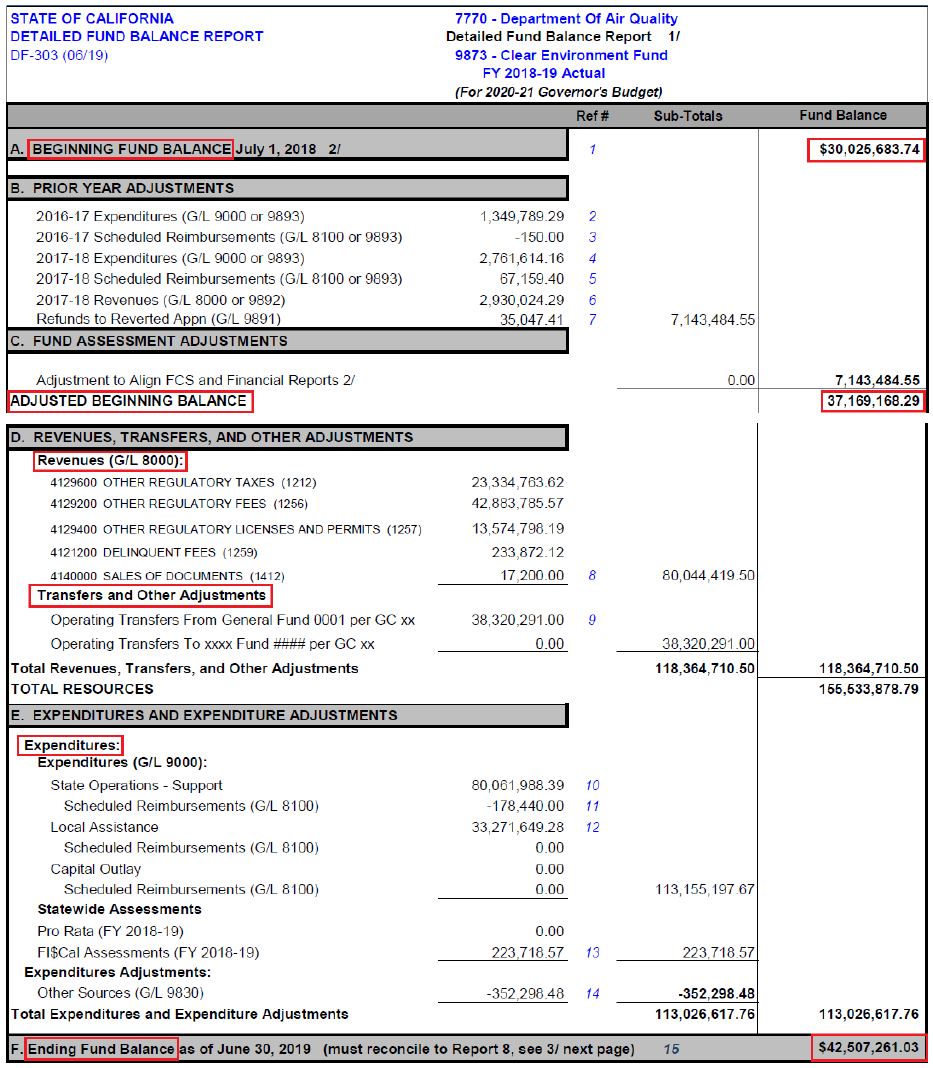
9
The Detailed Fund Balance Report (DF-303) is an accounting reconciliation document that
displays past year actuals for a fund. The DF-303 should tie to the Year End backup reports and
should be clearly annotated.
Below is an example of a DF-303 that has been annotated, annotations should be numbered
and tie to the FCS and the backup accounting documents. Note that the “8” entered into the
Ref # column next to “80,044,419.50” ties to the sum of the values annotated with a circled “#8”
on the FCS above.

10
Year End Statement of Revenues (Report 4): An accounting reconciliation document that ties to
the Revenues, Transfers and Other Adjustments section of the DF-303.
Below is an example of provided accounting documents that is fully annotated, annotations
should be numbered and tie to the DF-303. Note that that the circled “#8” in this sample
Report 4 matches the amounts annotated with the #8 on the previous two samples.
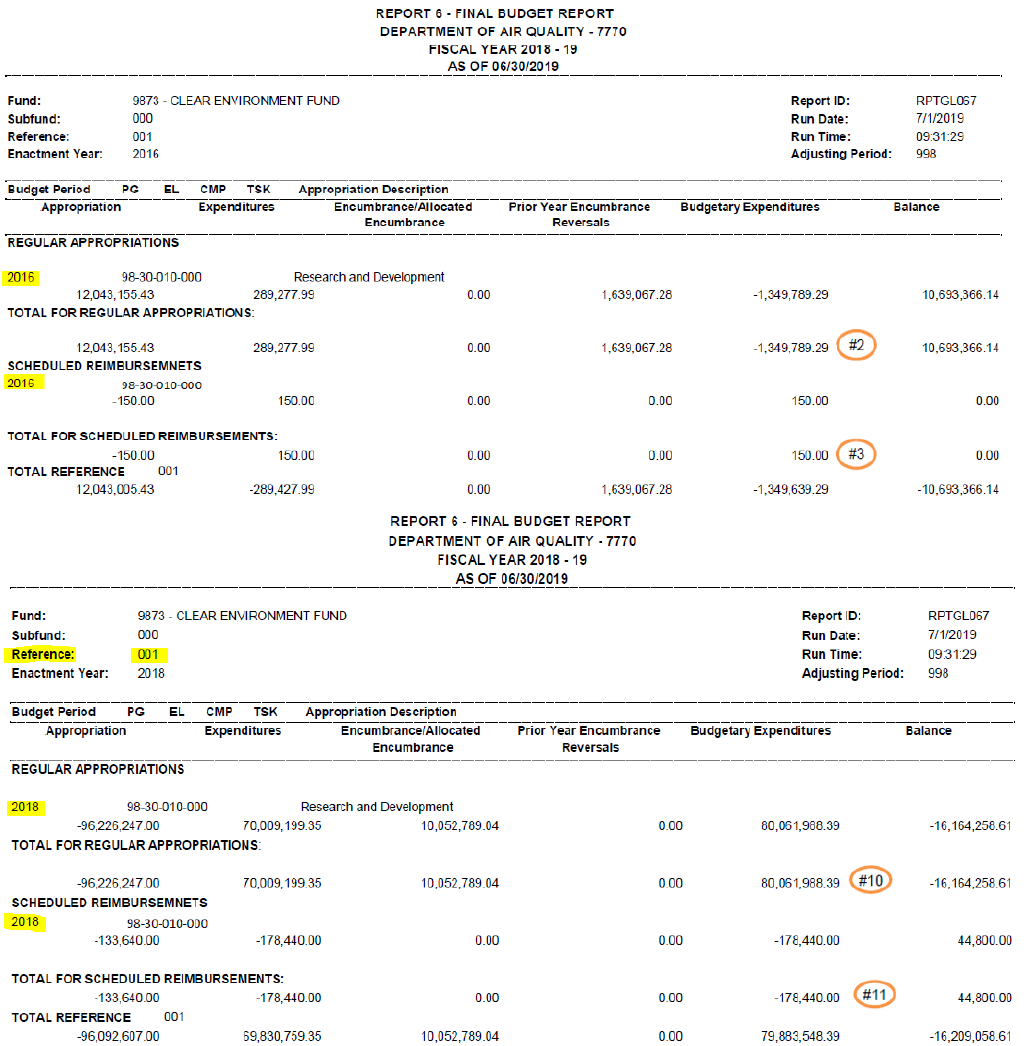
11
Final Budget Report (Report 6): Provides a detailed breakdown of expenditure amounts for both
past year and prior years. Below is an example of the accounting document that is fully
annotated. Annotations should be numbered and tie to the DF-303.

12
Analysis of Change in Fund Balance (Report 9): Provides a summarized view of the
components of a fund’s balance. Below is an example of the accounting document that is fully
annotated. Annotations should be numbered and tie to the DF-303.
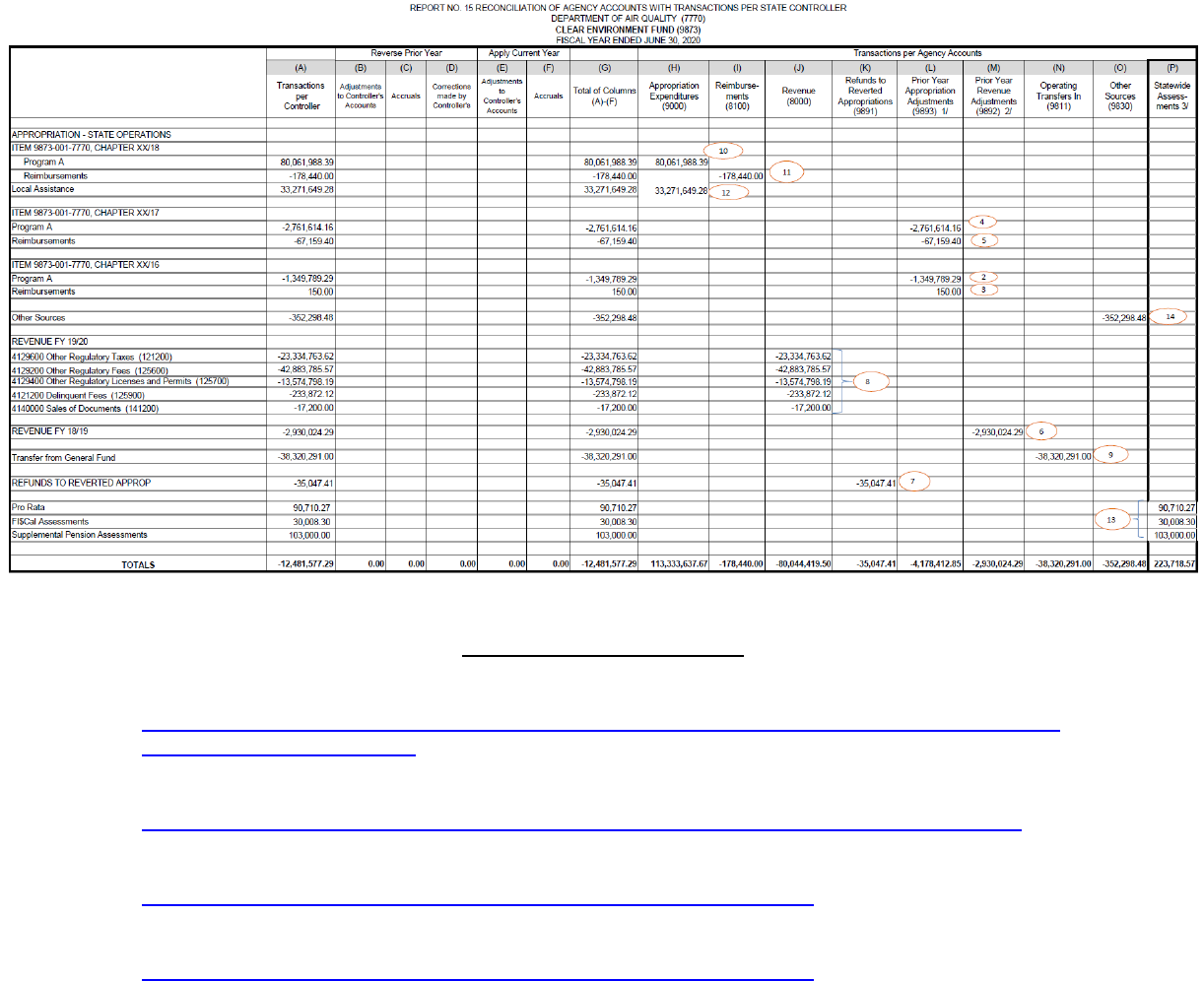
13
Reconciliation of Agency Accounts with Transactions per State Controller (Report 15): Provides
a summary of fund activity for expenditures and resources. Below is an example of the
accounting of a fully annotated document. Annotations should be numbered and tie to the
DF-303. This will allow for a smoother fund reconciliation process.
Other Resources Available
Fund Balance Reconciliation Guide:
http://www.dof.ca.gov/Accounting/Policies_and_Procedures/Fund_Reconciliation/documents/Fu
ndBalanceReconciliation.pdf
Past Year Fund Reconciliation Forms:
http://www.dof.ca.gov/Accounting/Policies_and_Procedures/Fund_Reconciliation/index.html
BL 20-17:
http://www.dof.ca.gov/Budget/Budget_Letters/documents/BL20-17.pdf
BL 19-07:
http://www.dof.ca.gov/Budget/Budget_Letters/documents/BL19-07.pdf
